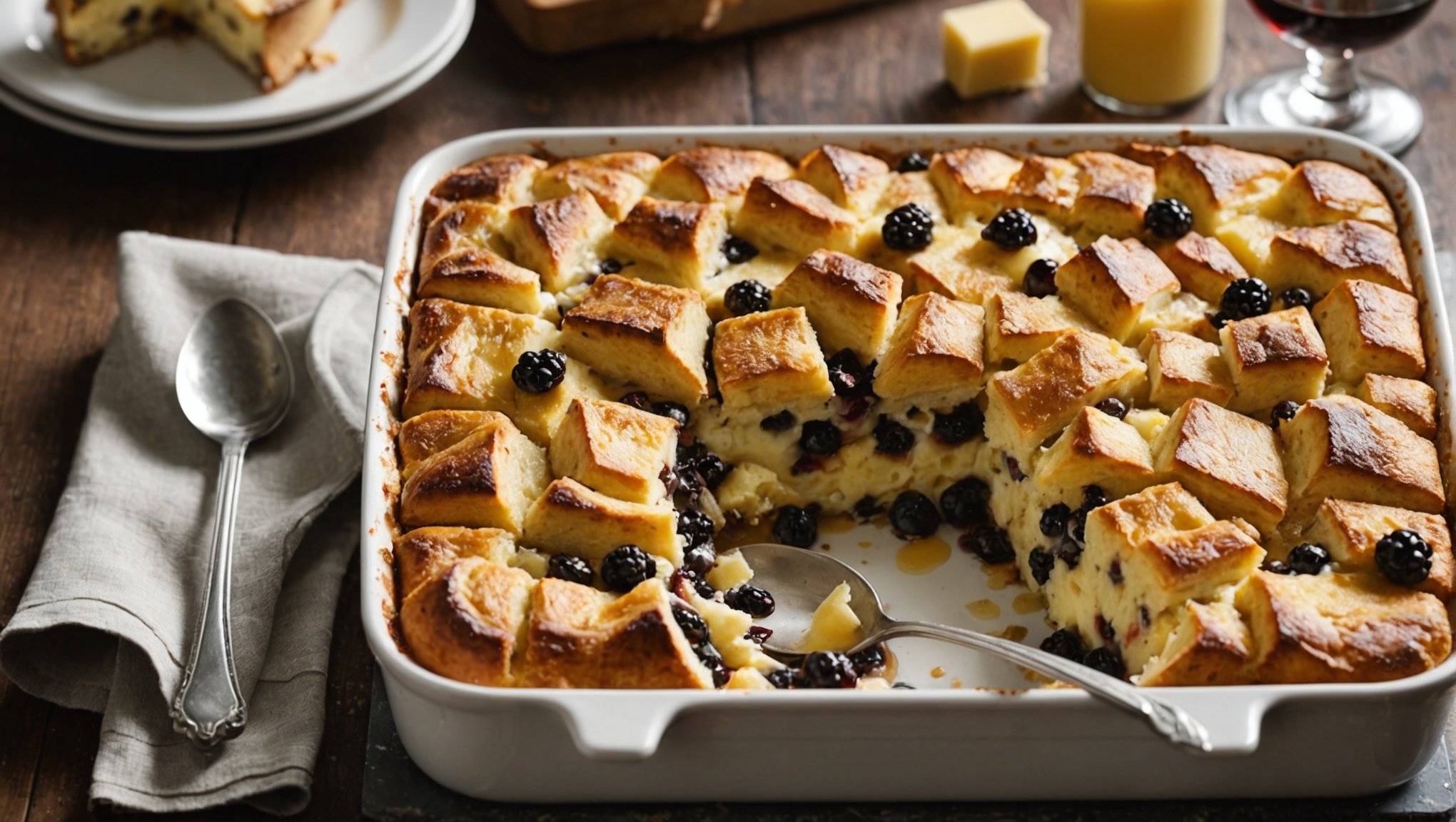Essential Ingredients for Bread and Butter Pudding
Creating a delectable bread and butter pudding begins with choosing the right ingredients. Key to achieving a rich and creamy texture are high-quality dairy products and freshly baked bread. These components work together to elevate this classic dessert into a luscious treat.
Key Ingredients
-
Bread: Opt for bread that absorbs flavours well, such as brioche or challah. They impart a buttery richness that complements the pudding’s creamy custard.
Also read : Elevate Your Meal with a Zesty Thai Beef Salad drizzled in Lime Dressing!
-
Dairy: Use whole milk and double cream for the custard. These enhance the lusciousness and create a silky texture.
Enhancements and Variations
While traditional recipes provide comfort through simplicity, personalising with add-ins or substitutions can cater to dietary needs. For instance, replacing milk with almond or coconut milk can accommodate lactose intolerance without sacrificing taste. Additionally, consider incorporating:
Also to read : Mastering the Art of English Pork Pie: Create the Ultimate Hot Water Crust Delight!
-
Dried fruits: Raisins or sultanas add bursts of sweetness and texture.
-
Nuts: Add crunch with almonds or walnuts.
These variations offer flexibility, allowing you to adapt the classic pudding to individual taste preferences while maintaining its classic charm.
Step-by-Step Recipe for Bread and Butter Pudding
Creating a delightful bread and butter pudding is both simple and rewarding. Here, we provide an easy-to-follow recipe format to ensure your pudding turns out perfectly every time. Begin by gathering ingredients like stale bread, butter, eggs, milk, sugar, and a hint of cinnamon.
Preparing the Base
Begin by preheating your oven to 180°C (350°F). Butter the bread slices generously, as this ensures a rich flavour once baked. A layering technique is crucial: arrange a layer of buttered bread neatly in a greased ovenproof dish. In a separate bowl, whisk together eggs, milk, and sugar until smooth – this is your pudding base.
Layering Technique
Pour a portion of the pudding base over the bread, allowing it to soak. Repeat with another layer of bread and more pudding base. This method ensures each slice of bread absorbs the mixture evenly, resulting in a moist pudding.
Optimal Cooking Time and Temperature
Bake in the preheated oven for 35-40 minutes. Assess doneness by checking if the pudding is golden brown and slightly puffed. Cooking at the correct temperature is key to achieving the perfect texture: a light, buttery crust with a warm, creamy center.
Techniques for Achieving Richness and Creaminess
It’s essential to consider the bread and butter pudding texture tips to ensure a luscious dessert. One critical step involves soaking the bread thoroughly. Proper soaking allows the bread to absorb the custard mixture deeply, which prevents dryness and promotes richness. To achieve this, let the bread sit in the egg and cream mixture for at least half an hour before baking. This ensures the bread is saturated, enabling it to bake into a soft and custardy texture.
Eggs and cream are pivotal in enhancing the pudding’s creaminess. Eggs act as a binding agent and contribute to the pudding’s silky nature when cooked. The cream adds a luxurious richness, making each bite indulgent. For a perfectly creamy texture, maintain a balance between eggs and cream; generally, three eggs to one cup of cream works well.
Avoiding common pitfalls is crucial for a successful pudding. A frequent mistake is baking at too high a temperature, which can dry out the pudding. Bake at a moderate temperature of about 160°C to 170°C. This gentle heat cooks the pudding evenly, ensuring a creamy, melt-in-the-mouth result every time.
Flavor Enhancements and Variations
Bread and butter pudding is a versatile dessert that shines through its ability to incorporate a myriad of flavoring options. Starting with the basics, spices such as cinnamon and nutmeg can elevate its warmth and depth. For those seeking a refreshing contrast, the zest of oranges or lemons can add a zesty punch that brightens each bite.
Choosing the right bread is equally impactful. Traditional white bread provides a neutral base, allowing other flavors to shine, while using brioche or challah offers a richer, more indulgent experience. Incorporating raisin bread or sourdough can add unique textures and dimensions, moulding the bread and butter pudding variations to your liking.
For a creative twist, consider integrating rich chocolate chips or swirls of Nutella, bringing a decadent touch to the classic. An infusion of fruits such as raspberries or apples can introduce a natural sweetness, contrasting splendidly with the creaminess of the custard. Don’t shy away from exploration: a sprinkle of almond flakes or a drizzle of caramel can enhance the pudding, making it not just a dessert, but a canvas for your culinary creativity.
Serving Suggestions and Pairings
Bread and butter pudding shines with excellent sauces and toppings. A classic choice is a warm custard or vanilla sauce, which adds a creamy richness that perfectly complements the pudding’s texture. For those seeking an extra layer of flavour, consider infusing the custard with a hint of cinnamon or nutmeg. Alternatively, a dollop of whipped cream or a scoop of vanilla ice cream can add a refreshing, velvety touch.
In terms of presentation, arranging the slices artfully within the dish and dusting the top with powdered sugar elevates the pudding’s visual appeal. You can accentuate this rustic dessert by garnishing it with fresh seasonal fruits like berries or sliced peaches.
Regarding beverages, a well-paired drink can transform the dessert experience. A dessert wine, such as Sauternes or a rich Port, aligns with the pudding’s sweetness beautifully. For non-alcoholic options, consider serving it with a fragrant earl grey tea or a chai latte. These choices balance the pudding’s rich flavours with their aromatic notes.
All these elements together can transform a simple dessert into a memorable delight, ensuring every serving is visually engaging and palatably pleasing.
Nutritional Information and Tips for Healthier Versions
Understanding the nutritional content of a standard bread and butter pudding serving is crucial for those mindful of their intake. Typically, a portion includes significant calories, fats, and sugars. However, there are various ways to enjoy a healthier dessert without compromising on taste.
To reduce the calorie count, consider swapping the traditional ingredients for healthier alternatives. For instance, replacing full-fat milk with skimmed or plant-based milk can lower fat content considerably. Similarly, using whole-grain bread instead of white bread adds nutritional benefits like fibre, which promotes better digestive health.
Reducing sugar is another effective way to make this dessert healthier. Swap out regular sugar for natural sweeteners like honey or stevia, or simply reduce the quantity used. Incorporating fruits like raisins or sliced bananas can naturally enhance sweetness while adding vitamins and minerals.
Moreover, opting for low-fat butter or margarine contributes to a healthier version. Always remember that ingredient choices play a significant role in the overall healthfulness of your dish. Experimenting with spices, such as cinnamon or nutmeg, can also enhance flavour without extra calories.











